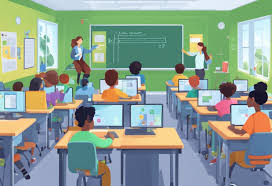In today’s digital age, the classroom extends far beyond four walls. Teachers are constantly seeking innovative tools to capture students’ attention and enhance learning experiences. Among these tools, kids animated shows have emerged as powerful educational resources that combine entertainment with learning. When skillfully integrated into educational strategies, these colorful, character-driven narratives can reinforce curriculum concepts while keeping young learners engaged.
The synergy between educators and quality animated content creates a potent learning environment. While traditionalists might view screen time with skepticism, research increasingly supports the educational value of well-crafted animations. These shows often address complex topics through accessible storytelling, visual metaphors, and relatable characters that resonate with young audiences. The pedagogical potential multiplies when knowledgeable educators guide discussions, activities, and reflections based on these animated experiences.
The Science Behind Animation and Learning
Children’s developing brains are particularly receptive to visual storytelling. Cognitive science research indicates that information presented through multiple channels—visual, auditory, and narrative—creates stronger neural connections and improves retention. Animated content excels at this multi-sensory presentation, making abstract concepts tangible through vibrant visualization.
The combination of movement, color, sound, and story activates different regions of the brain simultaneously. When children watch educational animations, they engage both the language processing centers and visual cortex, creating rich, multi-dimensional learning experiences. This neurological engagement explains why concepts introduced through animation often remain with children long after viewing.
Character Connection and Social-Emotional Learning
Beyond academic content, quality animated programming frequently emphasizes character development and social-emotional learning. Children form parasocial relationships with animated characters, viewing them as friends and role models. These connections create safe spaces for exploring emotions, relationships, and moral dilemmas.
Many animated series deliberately incorporate lessons about empathy, conflict resolution, perseverance, and emotional regulation. When educators reference these character experiences in classroom discussions, children can process complex social concepts through the comfortable distance of animated scenarios before applying these insights to their own interactions.
Representation and Global Awareness
Modern animated content increasingly embraces diverse representation, exposing children to various cultures, abilities, family structures, and perspectives. This representation matters deeply, as it helps children develop appreciation for diversity while providing crucial mirrors and windows—mirrors that reflect their own identities and windows into experiences different from their own.
Thoughtful educators can leverage these animated explorations of diversity to foster inclusive classroom environments and global awareness. Animation’s ability to transport viewers anywhere—from ocean depths to outer space, from ancient civilizations to future worlds—expands children’s horizons beyond what’s physically accessible in traditional learning environments.
Critical Viewing Skills and Media Literacy
As digital natives, today’s children need guidance in developing critical media literacy. Educational settings that incorporate animated content provide perfect opportunities for teaching these essential skills. Educators can help young viewers analyze story elements, distinguish fact from fiction, identify persuasive techniques, and recognize both positive and problematic representations.
These discussions plant seeds for lifelong critical thinking. By asking questions about animated content—Who created this? What choices did they make? What messages are being communicated?—teachers help children become thoughtful consumers rather than passive viewers.
Interactive Learning Extensions
The most effective educational approaches don’t treat animated content as stand-alone instruction but as springboards for deeper exploration. Creative educators develop hands-on activities, art projects, dramatic play scenarios, and science experiments inspired by animated shows. These extensions transform passive viewing into active learning experiences.
For example, a show about ocean conservation might prompt classroom recycling initiatives, while a mathematical adventure might inspire puzzle-solving competitions. These connections between screen and real-world applications strengthen learning transfer and demonstrate the relevance of both animated content and academic concepts.
Digital Citizenship Foundations
As children navigate increasingly digital lives, animated content can introduce fundamental concepts of digital citizenship. Shows that model responsible technology use, online safety, and ethical digital behavior provide valuable starting points for these crucial conversations. When educators build upon these themes, they prepare students for the complex digital landscape they will navigate throughout their lives.
Balancing Screen Time and Active Learning
Despite animation’s educational potential, balance remains essential. Thoughtful educators recognize that animated content serves as one tool within a diverse pedagogical toolkit. The most effective approaches combine limited, high-quality screen experiences with abundant opportunities for movement, social interaction, creative expression, and hands-on exploration.
Conclusion
The educational landscape continues to evolve, with technology playing an increasingly significant role. Animation offers unique advantages as an educational medium—engaging multiple learning pathways, creating emotional connections, and making complex concepts accessible. When education professionals thoughtfully integrate quality animated content into comprehensive learning experiences, they harness the medium’s full potential.
The most powerful learning happens at the intersection of engaging content and skilled facilitation. As both educational animation and teaching strategies continue advancing, this partnership between animated content and pedagogical expertise promises even greater educational impact. The colorful characters and vibrant worlds that captivate young imaginations can, with proper guidance, become gateways to lifelong learning, critical thinking, and global understanding.

